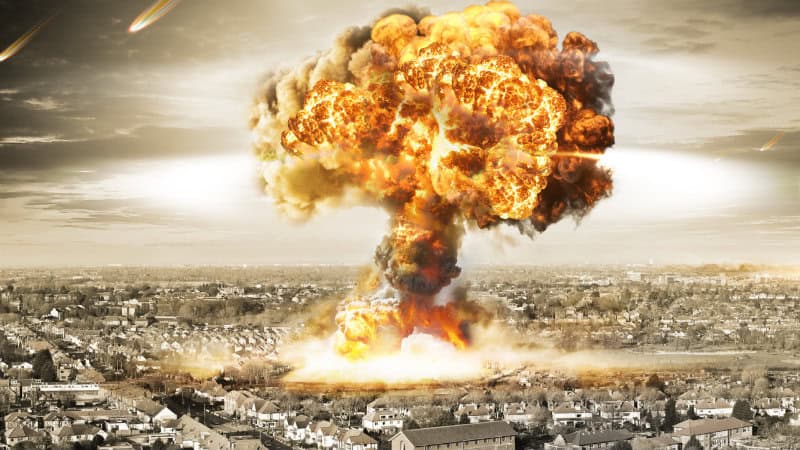LAHORE – Civil society and international organizations around the world are observing International Day for the Total Elimination of Nuclear Weapons today, September 26, with an aim to get rid of nuclear weapons to achieve the common goal of a nuclear-weapon free planet.
The Day provides an occasion for the world community to reaffirm its commitment to global nuclear disarmament as a high priority. It also gives an opportunity to educate the public – and their leaders – about the real benefits of eliminating such weapons, and the social and economic costs of perpetuating them.
Nuclear-armed states
There are eight sovereign states that have successfully detonated nuclear weapons. Five are considered to be “nuclear-weapon states” (NWS) under the terms of the Treaty on the Non-Proliferation of Nuclear Weapons (NPT). In order of acquisition of nuclear weapons these are: United States, Russia, United Kingdom, France, and China.
Since the NPT entered into force in 1970, three states that were not parties to the Treaty have conducted nuclear tests, namely India, Pakistan, and North Korea. North Korea had been a party to the NPT but withdrew in 2003.
Pakistan, India could slip into nuclear war, warns top expert
Israel, an illegal state in Palestinian territories, is estimated to have over 100 nuclear warheads.
The total number of nuclear weapons worldwide is estimated at over 15,000.

Warheads stockpile
United States: Developed first in an arms race with Nazi Germany (whose nuclear program was ultimately unsuccessful), then used in 1945 against Japan to end WWII and send a message to the Soviets. (About 4,800 usable warheads, 2,500 additional to be dismantled)
Russia: Developed in the Soviet Union to deter the West from doing the Unthinkable. (About 4,300 warheads, 3,700 additional to be dismantled)
United Kingdom: Developed to deter the Soviet Union. (Exclusively submarine-based, approx. 200 warheads)
France: Developed to deter the Soviet Union. (Approx. 300 warheads). France is also a world leader in peaceful use of nuclear power, deriving nearly 80% of its electrical needs from nuclear generation.
China: Developed to deter the US, and later the Soviet Union. (About 260 warheads)
India: Developed first to deter China and, later, Pakistan. (Between 100-120 nuclear warheads)
Pakistan: Built to deter India. (Between 110-130 nuclear warheads)
Israel: the only unconfirmed nuclear power. (An estimated 80 nuclear warheads, with fissile material for up to 200)
Atomic Bombs
The United States conducted its first nuclear test explosion in July 1945 and dropped two atomic bombs on the cities of Hiroshima and Nagasaki in August 1945.

Just four years later, the Soviet Union conducted its first nuclear test explosion. The United Kingdom (1952), France (1960), and China (1964) followed.
Massive mushroom cloud sparks ‘nuclear attack’ fears in Russia
Seeking to prevent the nuclear weapon ranks from expanding further, the United States and other like-minded states negotiated the nuclear Nonproliferation Treaty (NPT) in 1968 and the Comprehensive Nuclear Test Ban Treaty (CTBT) in 1996.
India, Israel, and Pakistan never signed the NPT and possess nuclear arsenals. Iraq initiated a secret nuclear program under Saddam Hussein before the 1991 Persian Gulf War. North Korea announced its withdrawal from the NPT in January 2003 and has tested nuclear devices since that time. Iran and Libya have pursued secret nuclear activities in violation of the treaty’s terms, and Syria is suspected of having done the same.
Still, nuclear nonproliferation successes outnumber failures and dire forecasts decades ago that the world would be home to dozens of states armed with nuclear weapons have not come to pass.
At the time the NPT was concluded, the nuclear stockpiles of both the United States and the Soviet Union/Russia numbered in the tens of thousands. Beginning in the 1970s, U.S. and Soviet/Russian leaders negotiated a series of bilateral arms control agreements and initiatives that limited, and later helped to reduce, the size of their nuclear arsenals. Today, the United States and Russia each deploy more than 1,500 strategic warheads on several hundred bombers and missiles, and are modernizing their nuclear delivery systems.
China, India, and Pakistan are all pursuing new ballistic missile, cruise missile, and sea-based nuclear delivery systems. In addition, Pakistan has lowered the threshold for nuclear weapons use by developing tactical nuclear weapons capabilities to counter perceived Indian conventional military threats. North Korea continues its nuclear pursuits in violation of its earlier denuclearization pledges.
North Korea conducts ‘successful’ 5th nuclear test
South Africa has the unique status of a nation that developed nuclear weapons but then disassembled its arsenal before joining the NPT. This means that there are three European countries, one country in North America, zero in South America, four Asian countries, zero Oceanian countries and zero African countries that are known to have nuclear weapons.
Game of Nukes
Nuclear war is the ultimate unthinkable. Countries possessing such weapons have well-funded, long-term plans to modernize their nuclear arsenals. More than half of the world’s population still lives in countries that either have such weapons or are members of nuclear alliances.
Also, the doctrine of nuclear deterrence persists as an element in the security policies of all possessor states and their nuclear allies.
The next review cycle of the Treaty on the Non-Proliferation of Nuclear Weapons begins in 2017. And the world cannot afford another round of inaction.
Sources: Wikipedia, Armscontrol.org













